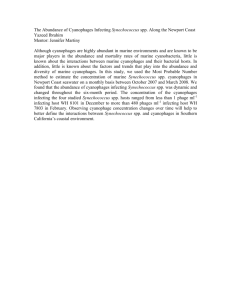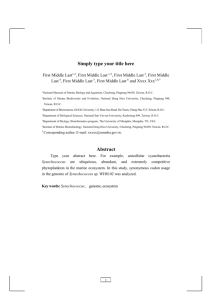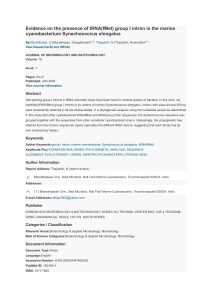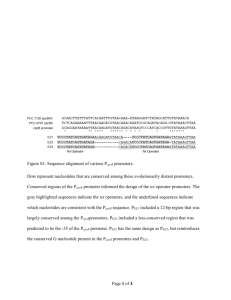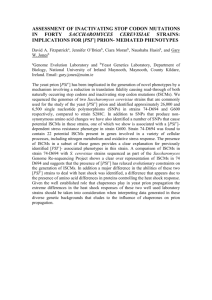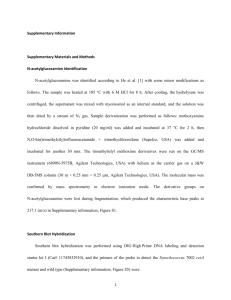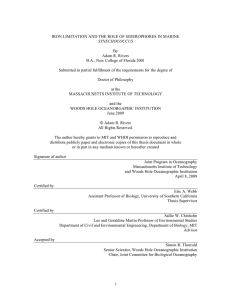Investigating the effect of motility on bacterial predation by a
advertisement
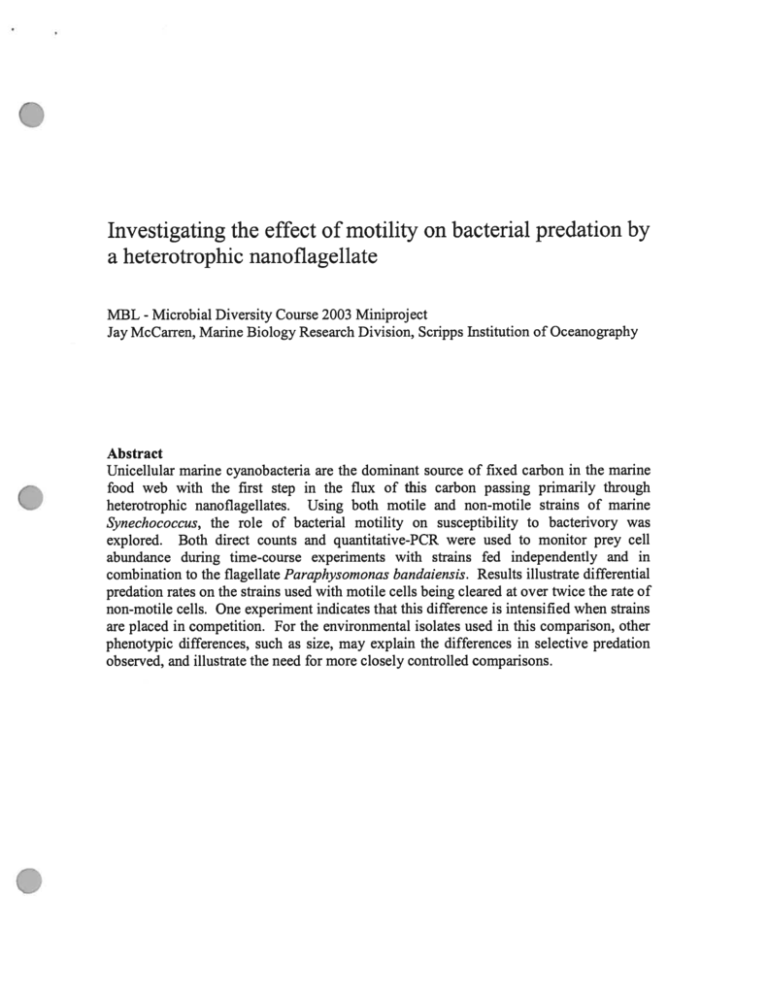
Investigating the effect of motility on bacterial predation by a heterotrophic nanoflagellate MBL Microbial Diversity Course 2003 Miniproject Jay McCarren, Marine Biology Research Division, Scripps Institution of Oceanography - Abstract Unicellular marine cyanobacteria are the dominant source of fixed carbon in the marine food web with the first step in the flux of this carbon passing primarily through heterotrophic nanoflagellates. Using both motile and non-motile strains of marine Synechococcus, the role of bacterial motility on susceptibility to bacterivory was explored. Both direct counts and quantitative-PCR were used to monitor prey cell abundance during time-course experiments with strains fed independently and in combination to the flagellate Paraphysomonas bandaiensis. Results illustrate differential predation rates on the strains used with motile cells being cleared at over twice the rate of non-motile cells. One experiment indicates that this difference is intensified when strains are placed in competition. For the environmental isolates used in this comparison, other phenotypic differences, such as size, may explain the differences in selective predation observed, and illustrate the need for more closely controlled comparisons. Introduction Oceanic primary productivity is dominated by small unicellular cyanobacteria of the genus Synechococcus and Prochiorococcus (Waterbury et al. 1986, Chishoim et al. 1988, Li et al. 1992, Landry et al. 1996). While knowledge of the physical and environmental factors that effect the growth of these phytoplankton has been investigated for some time and is reasonably well understood, comparatively little research has focused on the impact of predatory grazers on these globally important primary producers. These cells represent the major input of fixed carbon into the base of the marine food web, thus identifying the factors that affect their consumption by predators is crucial to understanding of the flow fixed carbon into the marine food web. Due to their small size, unicellular cyanobacteria are unlikely to be consumed directly by mesozooplankton but are certainly ingested by heterotrophic nanoflagellate predators. Heterotrophic nanoflagellates are small 1-l0jim eukaryotic predators of both photosynthetic and heterotrophic bacteria. Recent work has begun to outline both physical factors such as UV irradiation (Ochs & Eddy 1998), and biological characteristics such as cell size, morphology, motility, and cell surface hydrophobicity (Monger et al. 1999, Matz at el. 2002) that influence relative susceptibility of cells to predation. Specifically, Matz et al. (2002) report the finding of a significant positive relationship between bacterial swimming speed and increased contact rates between bacteria and flagellate predators. This was offset though, by a corresponding negative relationship between flagellate capture efficiency and bacterial swimming speed resulting in no significant difference in ingestion rates for motile cells compared to non-motile cells. Reported here are experiments designed to investigate the relationship between motility and predation. In a simplified model system, different strains of marine Synechococcus have been added to cultures of the commonly isolated heterotrophic nanoflagellate Paraphysoinonas bandaiensis. Predation upon Synechococcus by P. bandaiensis was quantitatively monitored, over relatively short time spans time (<24hrs), by two independent methods. Initial experiments were conducted with a model motile strain (strain WH8 102) and a non-motile mutant of WH8 102 (strain Si Al [Brahamsha 1996]). Subsequent experiments involved a motile environmental isolate (WH8 102) and a non-motile environmental isolate (WH7803). Methods Strains and Growth Conditions: Synechococcus strains WH8 102, WH7803, and S1A1-B(Brahamsha 1996), were maintained at 23°C on a l4hr/iOhr light dark cycle in SN(Waterbury & Willey 1988) media prepared from local seawater. Synechococcus strainWH8 102 is a motile strain, which exhibits a unique non-flagellar swimming motility. Synechococcus strain S1A1-B is a non-motile mutant strain derived from WH8012. Synechococcus strainWH78O3 is a naturally non-motile strain. Kanamycin was added at 20ig/ml to the media of mutant strain S1A1-B for maintenance of mutational insertion. P. bandaiesis was maintained in 30m1 cultures in the same incubator along with Synechococcus strains in 0.45 jim filtered local seawater + 0.0 1% yeast extract and a single grain of rice. Feeding experiments: J \1( a r. ri \[Hl \1 i oba1 D tt 2003 \lnup I’L.. 1 ?‘ F. bandaiensis cultures were prepared ‘—5days before use by inoculating 30m1 media with . 1 6 cells. m1 imi of a stationary phase culture resulting in working cultures of—4x10 by counts cells Synechococcus and Cells numbers were determined for P. bandaiensis using a hemacytometer and immobilizing onto 0.45 J.im filters respectively. For feeding experiments, prey cells were added to achieve a final concentration of 100 Synechococcus/P. bandaiensis (for competition experiment 50 WH8 102/P. bandaiensis and 50 WH7803/P. bandaiensis). Aliquots were removed at specific time points and split into two for quantification by the two methods described below. 1.0-1.5m1 used for direct counts and 1.5 ml used for DNA isolation for subsequent Quantitative-PCR. Sample processing (cell # quantification): Direct cells counts: Prior to fixation with 0.5% (final concentration) glutaraldehyde, P. bandaiensis cultures were anesthetized with 1.5% (w/v final 2 for 30seconds to prevent ejestion of food vacuole contents (J. concentration) NiCI Waterbury, F. Valois personal communication). When enumeration of P. bandaiensis % proflavine. After fixing and staining, 4 was required, samples were stained with 5x10 cells were immobilized on black 0.4511m nucleopore filters and visualized by epifluorescence using both a rhodamine filter and an acridine orange filter to enumerate cells. All samples counted within 8hrs of fixation. Quantitative-PCR: Cells pelleted by centrifugation at ‘—14K RPM for lOrninutes then resuspended with 300il bead solution provided in MoBio UltraClean Soil DNA kit (MoBio, Solana Beach CA), mixed with beads in vial and frozen until ready to process all samples. DNA extraction procedure performed as per manufacturers instructions for maximum yields with the addition of 2 freeze-thaw cycles at the beginning of the protocol. Quantitative-PCR (Q-PCR) was performed using a Bio-Rad iCycler iQ real time detection system(Bio-Rad, Hercules CA). 25ji1 reactions were prepared in 96 well plates using Bio-Rad iQ SYBR green supermix, oligos at 1iM, and 1-5pi template DNA. Oligos selected to amplify a small fragment 80-160 bp in length. For all experiments a hot start 2-step amplification reaction was run with 20 sec denaturation at 95°C, 60 sec annealing and extension at 60°C cycled 50 times. All samples run in duplicate including . Oligos used: swmA 7 7 targets/reaction to 1x10 standard curve, which ranged from 5x10 specific forward (Al) 5’-CTTGGCGTCAAGGAACCAAT-3’, swmA specific reverse (A2) 5’- CATTCCTTCCGTGGCAACTC-3’, motility mutant specific reverse primer (Vi) 5’- TCATACACGGTGCCTGACTG, cyano specific 16S forward (CYA 359F) 5’GGGGAATYTTCCGCAATGGG -3’ (Nubel et. al 1997), universal bacterial 16S reverse (S*Univ 519R) 5’- GWATTACCGCGGCKGCTG -3’ (Amann et al. 1995). Controls were performed to confirm that the primer set Ai&A2 specifically amplified DNA from motile strain WH8 102 and would not amplify WH7803 DNA as well as to confirm that primer set CYA 359F & S*Univ 519R would amplify both WH7803 and WH8 102 while not amplifying P. bandaiensis culture community DNA. 3. \i( arrn. N1HL \iicrohjal I)iver’tv 2003 Minipiojct Pa2e :f Results Initial experiments were carried out feeding Synechococcus strains independently to the P. bandaiensis predator. A logarithmic loss of Synechococcus cells is observed for the two strains as detected by both techniques (Fig. 1). Moreover, there was a close correspondence in the rate of grazing predation as monitored by the two methods employed. No clear difference in mortality rate between motile strain WH8 102 and the non-motile mutant S1A1-B was observed. Unfortunately, the S1A1-B culture was not growing well and there were not sufficient cells to add a quantity to give equal starting concentrations for the two treatments. The poor condition of the culture also made direct counts difficult due to the variable and inconsistent autofluorescence from the Si Al-B cells. Additionally, for the last time point at nine hours post-addition, no S1A1-B cells could be observed in the directly counted treatment and this data point has been omitted from the linear regression plot. Manual counts A Quantitative-PCR B • W-18102 SIA1 • M-6 102 (Al&A2) ASIAI (A&Vl) (AMOS y=-O 192x—7493 7- E E 00 00 8 0) 0 0 -J -J 5-I 4 4- 0 2 4 6 8 10 flme(hr) 0 2 4 6 8 10 Time (IT) Fig. 1. Time course changes in prey abundance as monitored by direct counts (A) and Q-PCR (B). Strain S IAI was quantified by Q-PCR using two independent genetic loci denoted by primer pairs listed in parentheses. Following this first experiment, the non-motile mutant culture S1A1-B died. Another non-motile strain was employed in the following experiment, this time the naturally non-motile environmental isolate WH7 803. Once more, the test Synechococcus strains were fed independently to the P. bandaiensis predator. A close correspondence was again observed between the two methods of quantification (Fig. 2). A distinct difference is observed in the rate at which these two strains are being cleared from the culture. WH8 102 is being cleared at a rate of approximately 34% of the Synechococcus stock hr -I while WH7803 is being cleared at a rate less than half of that (-15% Syn stock hr -1). Furthermore, the predation rate of P. bandaiensis on WH8 102 was essentially unchanged from the first to the second experiment (see slope of lines Figures 1A, IB,2A,arid2B). J. \IcCarren. \-IBL Microbial Diersii 2003 Miniproject Paie 4 of 8 A B Fed Individually Manual Counts - Fed Individually Q-PCR - 9 9- I 8 7- •WH8102 0, CYA359Fa SUnv519R) •WH8102 03 0) 1WH7803 6 •;°6- •VvH81O2 14 y=-oI 7 . 8 ,+ 72 (AI&A2) -j •‘M-17803 (CYA359F& S’Ur.v519R) 5- 5- 4 ———--—---— 4 0 5 15 10 20 0 25 5 15 20 — - —— 25 Time (hrs) Time (hrs) C ——-—-—-—---—-----— 10 Competition Q-PCR 8- •WH8102 7- (*l&A2) 0, • WH7 803 C 0 06 Fig. 2. Time course changes in prey abundance as monitored by direct counts (A) and Q-PCR (B)(C). (B) WH8102 quantified by Q-PCR using two independent genetic loci denoted by primer pairs listed in parentheses. (C) Competition experiment in which both WH8 102 and WH7803 were added as prey. Primers used to amplify genes listed in parentheses. WH7803 abundance inferred as the difference between total Synechococcus and WH8 102. Total Svn cyas,ca ..0 SUv5I9al 5 4 -— 0 5 15 10 20 25 lime (hrs) Observations of directly counted cells at the fmal time point illustrate another difference between the predation of P. bandaiensis on WH8 102 as compared to WH7803. After incubating WH8 102 21 hours with P. bandaiensis, very few Synechococcus cells remain and those seen are unicellular and well dispersed. In contrast the WH7803 fed culture contains primarily clumps of cells ranging from just a few to greater than fifty cells per aggregate. Although isolated single cells are still observed the majority of the prey cells remaining are found associated into multicellular clusters (Fig 3). Preliminary experiments were all designed around the goal of feeding strains to a predator in combination to observe what happens to predation rate in a competitive situation. Figure 2C shows the change over time in both total Synechococcus and strain WH8 102 along with the inferred concentration of WH7803. WH7803 concentration is assumed to be the difference between the total Synechococcus concentration and WH8 102 concentration. [Synechococcus strain WH7 803] [Total Synechococcus] J. McCarren. MBL \licrohial Diversit 2003 \‘liniproject — [Synechococcus strain WH8 1021 Page 5 of 8 Fig. 3. Epifluorescence micrograph of remaining Synechococcus sp. strain WH7803 cells 21 hours post feeding to °. bandaiensis. Majority of cells present in large multicellular cluster with individual cells indicated by arrows, Within the first 10 hours the concentration of WH8 102 dropped dramatically, much more rapidly than observed when fed in isolation to P. bandaiensis. Interestingly, at the final time point WH8 102 abundance had not dropped any further and may even indicate that these cells are increasing in number after having reached a minimum. As a means of comparison, a linear regression line was fit to all points except this last time point. Calculating a predation rate based on this line yields a rate of approximately 50% of the WI-18 102 stock hr -1• While the predation rate of P. bandaiensis on WH8 102 appears to have increased when in competition no obvious change in predation rate on WH7803 is seen when in competition. . . Discussion These results show the promise of Q-PCR as a tool for quantifying different populations of cells in applications where microscopic differentiation of cells is not possible. In both experiments the rate of predation observed by direct counts very closely matched that determined by Q-PCR. In the first experiment, the absolute value of cell concentrations correlated very well between these two methods of quantification. This close correspondence did not hold up in the second experiment with Q-PCR giving values up to an order of magnitude greater than direct counts. This disparity was likely due to difficulties in obtaining accurate DNA concentrations of nucleic acid isolated using the MoBio kit for use in generating a standard curve. In spite of this possible source of error, Q-PCR remains a robust means for measuring relative levels of specific populations. Experiments in which different strains of Synechococcus were fed independently to P. bandaiensis show a distinct difference in the rate at which this flagellate ingests particular cells. Additionally, the one competition experiment conducted suggests that this discrepancy between predation rates is magnified when strains are fed in combination. While several recent reports have documented flagellates grazing at different rates on Prochiorococcus as compared to Synechococcus (Guillou at al. 2001, Christaki et al. 2002, Worden & Binder 2003) the results presented here show that grazing predation may have a significant influence on community structure at an even finer level. These results suggest that motile cells may be at a disadvantage to non-motile cells in regard to predation susceptibility. Matz et al. (2002) investigated the effect of motility on predation and showed an increased encounter frequency for motile cells but corresponding decrease in capture efficiency by the flagellate, the net result being no change in net ingestion of motile cells compared to non-motile ones. The authors suggest that the decreased capture efficiency may be due to “run and reversal” motion typical of many marine bacteria with reversals J. McQarren. MBL Microbial DRersity 2003 \4inipwjecl Page 6 of S acting as an active predator avoidance strategy. If this is the case, motile marine Synechococcus spp. offer an interesting comparison as these cells swim in seemingly random ioopy paths never reversing directions or tumbling to reorient. Thus the above results are consistent with the possibility that motile Synechococcus have an increased encounter frequency with predators due to motility but gain no offsetting reduction in escape frequency due to their swimming behavior. While the aim of this study was to investigate the role of motility in susceptibility of bacterial populations to predation, various other differences between these two strains may be dominating the basis of differential predation observed. While both strains are marine Synechococcus, reports have shown this group to be highly divergent (Toledo & Palenik 1998, Toledo et al. 1999) and there are other phenotypic characteristics differing between these two strains such as pigment content. While motility is another clear difference, it seems likely that there may be other differences which the flagellates can discern that we cannot. These strains do not differ markedly in size but even small differences may be sufficient to create a selective difference such as that observed. Synechococcus sp. strain WH7803 is a notoriously “clumpy” strain (E. Webb, personal communication) which may be an important factor for its apparent resistance to grazing. Observations at the end of the feeding experiment show a conspicuous difference between the two strains under investigation. While WH8 102 had largely vanished, WH7803 had declined to 2-3% of the original starting concentration. It is not clear if clustering occurred in response to grazing pressure or if this fraction of WH7803 cells were clustered into multicellular groups prior to incubation. In either case, this observation lends some credibility to the hypothesis that size selective feeding resulted in the observed differences in survival of these two strains. Results using isogenic populations of a wild-type strain and specific mutants derived from this strain were unfortunately inconclusive. Such an experiment would eliminate the uncertainty of potential differences between strains. The results from this miniproject indicate that the methods employed here should be able to detect differential grazing by predators and may be successfully employed, with appropriate cultures, to tease apart finer details of flagellate grazing preferences. Acknowledgments I would like to thank my advisor, Bianca Brahamsha, for encouraging me to attend this course and planting the idea upon which this project was based. John Waterbury was a huge help both in obtaining and maintaining several of the cultures used in this study. Both John Waterbury and Frederica Valois provided crucial tips on methods for working with flagellates and feeding experiments. Thanks also to my fellow students, TAs, and course instructors for encouragement with this work with special thanks to Terry Marsh for advice on Q-PCR. Cited References Amann RI, Ludwig W, Schleifer K}I (1995) Phylogenetic identification and in situ detection of microbial cells without cultivation. Microbial Reviews 59:143-169 J \h( \J1 \1t( iObh)1 I)i LI SI s \Inupi ojt 12( i ‘ Brahamsha B (1996) An abundant cell-surface polypeptide is required for swimming by the nonflagellated marine cyanobacterium Synechococcus. Proceedings of the National Academy of Sciences of the United States of America 93:6504-6509 Chishoim SW, Olsen RJ, Zettler, ER, Waterbury JB, Goencke R, Welschmeyer N (1988) A novel free living prochlorophyte occurs at high cell concentration in the oceanic euphotic zone. Nature 334:340-343 Christaki U, Courties C, Karayanni H, Giannakourou A, Maravelias C, Kormas K, Lebaron P (2002) Dynamic characteristics of Prochiorococcus and Synechococcus consumption by bacterivorous nanflagellates. Microbial Ecology 43 :341-352 Guillou L, Jacquet 5, Chretiennot-Dinet MJ, Vaulot D (2001) Grazing impact of two small heterotrophic flagellates on Prochiorococcus and Synechococcus. Aquatic Microbial Ecology 26:20 1-207 Landry M, Kirshtein J, Constantinou J (1996) Abundances and distributions of picoplankton populations in the central equatorial Pacific from 12N to 12S, 140N. Deep-Sea Research Part II Oceanographic Research Papers 43:871-890 Li WKM, Dickie PM, Irwin BD, Wood AM (1992) Biomass of bacteria, cyanobacteria, prochlorophytes and photosynthetic eukaryotes in the Sargasso Sea. Deep-Sea Research 39:501-5 19 Matz C, Boenigk J, Arndt H, Jurgens K (2002) Role of bacterial phenotypic traits in selective feeding of the heterotrophic nanoflagellate Spumella sp. Aquatic Microbial Ecology 27:137-148 Monger BC, Landry MR, Brown SL (1999) Feeding selection of heterotrophic marine nanoflagellates based on surface hydrophobicity of their picoplankton prey. Limnology and Oceanography 44:1917-1927 Nubel U, Garcia-Pichel F, Muyzer G (1997) PCR primer to amplify 16S rRNA genes from cyanobacteria. Applied and Environmental Microbiology 63 :3327-3332 Ochs CA & Eddy LP (1998) Effects of UV-A (320-399nm) on grazing pressure of a marine heterotrophic nanoflagellate on strains of unicellular cyanobacteria Synechococcus spp. Applied and Enviromental Microbiology 64:287-293 Toledo G, Palenik B (1997) Synechococcus diversity in the California current as seen by RNA polymerase (rpoCl) gene sequences of isolated strains. Applied and Environmental Microbiology 63:4298-4303 Toledo G, Palenik B, Brahamsha B (1999) Swimming marine Synechococcus strains with widely different photosynthetic pigment ratios form a monophyletic group. Applied and Enviromental Microbiology 65:5247-525 1 Waterbury TB, Watson SW, Valois FW, Franks DG (1986) Biological and ecological characterization of the marine unicellular cyanobacteri urn Synechococcus. Canadian Bulletin of Fisheries and Aquatic Sciences:71-120 Waterbury TB, Willey JM (1988) Isolation and growth of marine planktonic cyanobacteria. Methods in Enzymology 167:100-105 Worden AZ & Binder BI (2003) Application of dilution experiments for measuring growth and mortality rates among Prochiorococcus and Synechococcus populations in oliogtrophic evvironments. Aquatic Microbial Ecology 30:159174 J. \i(.airn. 11I \Iicrobial [)lversity 20()3 \iiniprojec Page of
